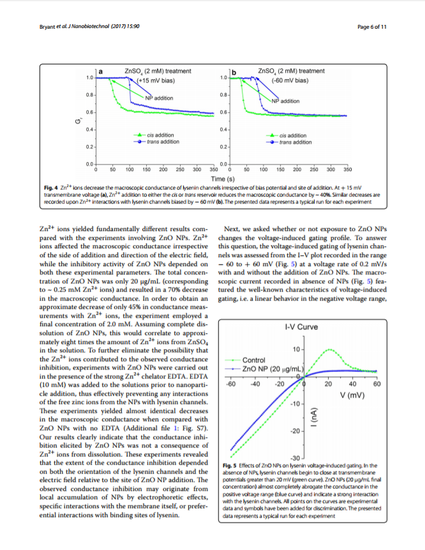
Background: The insufficient understanding of unintended biological impacts from nanomaterials (NMs) represents a serious impediment to their use for scientific, technological, and medical applications. While previous studies have focused on understanding nanotoxicity effects mostly resulting from cellular internalization, recent work indicates that NMs may interfere with transmembrane transport mechanisms, hence enabling contributions to nanotoxicity by affecting key biological activities dependent on transmembrane transport. In this line of inquiry, we investigated the effects of charged nanoparticles (NPs) on the transport properties of lysenin, a pore-forming toxin that shares fundamental features with ion channels such as regulation and high transport rate.
Results: The macroscopic conductance of lysenin channels greatly diminished in the presence of cationic ZnO NPs. The inhibitory effects were asymmetrical relative to the direction of the electric field and addition site, suggesting electrostatic interactions between ZnO NPs and a binding site. Similar changes in the macroscopic conductance were observed when lysenin channels were reconstituted in neutral lipid membranes, implicating protein-NP interactions as the major contributor to the reduced transport capabilities. In contrast, no inhibitory effects were observed in the presence of anionic SnO2 NPs. Additionally, we demonstrate that inhibition of ion transport is not due to the dissolution of ZnO NPs and subsequent interactions of zinc ions with lysenin channels.
Conclusion: We conclude that electrostatic interactions between positively charged ZnO NPs and negative charges within the lysenin channels are responsible for the inhibitory effects on the transport of ions. These interactions point to a potential mechanism of cytotoxicity, which may not require NP internalization.
This document was originally published in Journal of Nanobiotechnology by BioMed Central, Ltd an imprint of Springer Nature. This work is provided under a Creative Commons Attribution 4.0 license. Details regarding the use of this work can be found at: http://creativecommons.org/licenses/by/4.0/. doi: 10.1186/s12951-017-0327-9
Available at: http://works.bepress.com/daniel_fologea/24/
